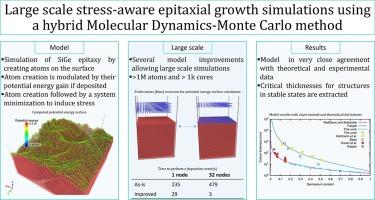基于混合分子动力学-蒙特卡罗方法的大规模应力感知外延生长模拟
IF 3.4
2区 物理与天体物理
Q1 COMPUTER SCIENCE, INTERDISCIPLINARY APPLICATIONS
引用次数: 0
摘要
采用分子动力学与蒙特卡罗相结合的大规模杂化方法,对硅锗异质外延过程进行了模拟,并预测了位错的出现。一方面,使用Tersoff势,分子动力学部分允许真实的结构松弛以及创建高度离散的势能面。另一方面,蒙特卡罗部分允许快速沉积模拟。进一步改进了该方法的组合,使其适用于两个不同的大尺度域。首先是拥有数百万个原子的结构,其次是拥有数千个处理核心的超级计算机环境。结果表明,在稳定状态下生长的异质外延结构的临界厚度非常接近。本文章由计算机程序翻译,如有差异,请以英文原文为准。

Large scale stress-aware epitaxial growth simulations using a hybrid Molecular Dynamics-Monte Carlo method
A large scale hybrid method combining Molecular Dynamics with Monte Carlo is implemented for the simulation of Silicon Germanium heteroepitaxy and the prediction of dislocation apparition. On one hand, using the Tersoff potential, the Molecular Dynamics part allows for realistic structure relaxation as well as the creation of a highly discretized potential energy surface. On the other hand, the Monte Carlo part allows for a fast deposition simulation. The combination is furthermore improved to apply the method in two different large scale domains. First, with structures holding millions of atoms and second in a supercomputer environment with thousands of processing cores. The method results show a very close agreement regarding the critical thickness of heteroepitaxied structures grown at their stable states.
求助全文
通过发布文献求助,成功后即可免费获取论文全文。
去求助
来源期刊

Computer Physics Communications
物理-计算机:跨学科应用
CiteScore
12.10
自引率
3.20%
发文量
287
审稿时长
5.3 months
期刊介绍:
The focus of CPC is on contemporary computational methods and techniques and their implementation, the effectiveness of which will normally be evidenced by the author(s) within the context of a substantive problem in physics. Within this setting CPC publishes two types of paper.
Computer Programs in Physics (CPiP)
These papers describe significant computer programs to be archived in the CPC Program Library which is held in the Mendeley Data repository. The submitted software must be covered by an approved open source licence. Papers and associated computer programs that address a problem of contemporary interest in physics that cannot be solved by current software are particularly encouraged.
Computational Physics Papers (CP)
These are research papers in, but are not limited to, the following themes across computational physics and related disciplines.
mathematical and numerical methods and algorithms;
computational models including those associated with the design, control and analysis of experiments; and
algebraic computation.
Each will normally include software implementation and performance details. The software implementation should, ideally, be available via GitHub, Zenodo or an institutional repository.In addition, research papers on the impact of advanced computer architecture and special purpose computers on computing in the physical sciences and software topics related to, and of importance in, the physical sciences may be considered.
 求助内容:
求助内容: 应助结果提醒方式:
应助结果提醒方式:


